Long-Term Effects of Mistletoe Removal on Radial Growth of Semi-Arid Aleppo Pine Forests
Abstract
:1. Introduction
2. Materials and Methods
2.1. Study Sites and Climatic Data
2.2. Mistletoe Treatment and Field Sampling
2.3. Dendrochronological Methods
2.4. Statistical Analysis
3. Results
3.1. Differences in Radial Growth Patterns between Mistletoe Treatments
3.2. Long- and Short-Term Growth Responses to Climate and Drought
3.3. Changes in Climate–Growth Relationships Related to Mistletoe Removal
4. Discussion
5. Conclusions
Supplementary Materials
Author Contributions
Funding
Data Availability Statement
Acknowledgments
Conflicts of Interest
References
- Norton, D.A.; Carpenter, M.A. Mistletoes as parasites: Host specificity and speciation. Trends Ecol. Evol. 1998, 13, 941–947. [Google Scholar] [CrossRef] [PubMed]
- Muche, M.; Muasya, A.M.; Tsegay, B.A. Biology and Resource Acquisition of Mistletoes, and the Defense Responses of Host Plants. Ecol. Process. 2022, 11, 24. [Google Scholar] [CrossRef]
- Griebel, A.; Watson, D.; Pendall, E. Mistletoe, Friend and Foe: Synthesizing Ecosystem Implications of Mistletoe Infection. Environ. Res. Lett. 2017, 12, 115012. [Google Scholar] [CrossRef]
- Mathiasen, R.L.; Nickrent, D.L.; Shaw, D.C.; Watson, D.M. Mistletoes: Pathology, Systematics, Ecology, and Management. Plant Dis. 2008, 92, 988–1006. [Google Scholar] [CrossRef] [PubMed]
- Dobbertin, M.; Rigling, A. Pine Mistletoe (Viscum album ssp. austriacum) Contributes to Scots Pine (Pinus sylvestris) Mortality in the Rhone Valley of Switzerland. For. Pathol. 2006, 36, 309–322. [Google Scholar] [CrossRef]
- Kollas, C.; Gutsch, M.; Hommel, R.; Lasch-Born, P.; Suckow, F. Mistletoe-Induced Growth Reductions at the Forest Stand Scale. Tree Physiol. 2018, 38, 735–744. [Google Scholar] [CrossRef] [PubMed]
- Glatzel, G.; Geils, B.W. Mistletoe Ecophysiology: Host-Parasite Interactions. Botany 2009, 87, 10–15. [Google Scholar] [CrossRef]
- Rigling, A.; Eilmann, B.; Koechli, R.; Dobbertin, M. Mistletoe-Induced Crown Degradation in Scots Pine in a Xeric Environment. Tree Physiol. 2010, 30, 845–852. [Google Scholar] [CrossRef] [PubMed]
- McDowell, N.G.; Sapes, G.; Pivovaroff, A.; Adams, H.D.; Allen, C.D.; Anderegg, W.R.L.; Arend, M.; Breshears, D.D.; Brodribb, T.; Choat, B.; et al. Mechanisms of Woody-Plant Mortality under Rising Drought, CO2 and Vapour Pressure Deficit. Nat. Rev. Earth Environ. 2022, 3, 294–308. [Google Scholar] [CrossRef]
- Zuber, D. Biological Flora of Central Europe: Viscum album L. Flora Morphol. Distrib. Funct. Ecol. Plants 2004, 199, 181–203. [Google Scholar] [CrossRef]
- López-Sáez, J.A.; Sanz de Bremond, C. Viscum album L. y Sus Hospedantes En La Península Ibérica. Bol. Sanid. Veg. Plagas 1992, 18, 817–825. [Google Scholar]
- Ne’eman, G.; Trabaud, L. Biogeography and Management of Pinus halepensis and P. brutia Forest Ecosystems in the Mediterranean Basin; Backhuys: Leide, The Netherlands, 2000. [Google Scholar] [CrossRef]
- Ramsauer, J.; Brotons, L.; Herrando, S.; Morán-Ordóñez, A. A Multi-Scale Landscape Approach to Understand Dispersal of the Mistletoe by Birds in Mediterranean Pine Forests. Landsc. Ecol. 2022, 37, 511–528. [Google Scholar] [CrossRef]
- Sangüesa-Barreda, G.; Camarero, J.J.; Pironon, S.; Gazol, A.; Peguero-Pina, J.J.; Gil-Pelegrín, E. Delineating Limits: Confronting Predicted Climatic Suitability to Field Performance in Mistletoe Populations. J. Ecol. 2018, 106, 2218–2229. [Google Scholar] [CrossRef]
- Gazol, A.; Ribas, M.; Gutiérrez, E.; Camarero, J.J. Aleppo Pine Forests from across Spain Show Drought-Induced Growth Decline and Partial Recovery. Agric. For. Meteorol. 2017, 232, 186–194. [Google Scholar] [CrossRef]
- Valeriano, C.; Gazol, A.; Colangelo, M.; Camarero, J.J. Drought Drives Growth and Mortality Rates in Three Pine Species under Mediterranean Conditions. Forests 2021, 12, 1700. [Google Scholar] [CrossRef]
- Ehleringer, J.R.; Schulze, E.D.; Ziegler, H.; L, L.O.; Farquhar, G.D.; Cowar, I.R. Xylem-Tapping Mistletoes—Water or Nutrient Parasites. Science 1985, 227, 1479–1481. [Google Scholar] [CrossRef] [PubMed]
- Zweifel, R.; Bangerter, S.; Rigling, A.; Sterck, F.J. Pine and Mistletoes: How to Live with a Leak in the Water Flow and Storage System? J. Exp. Bot. 2012, 63, 2565–2578. [Google Scholar] [CrossRef]
- Griebel, A.; Peters, J.M.R.; Metzen, D.; Maier, C.; Barton, C.V.M.; Speckman, H.N.; Boer, M.M.; Nolan, R.H.; Choat, B.; Pendall, E. Tapping into the Physiological Responses to Mistletoe Infection during Heat and Drought Stress. Tree Physiol. 2022, 42, 523–536. [Google Scholar] [CrossRef]
- Sangüesa-Barreda, G.; Carlos, J.; Camarero, J.J. Drought and Mistletoe Reduce Growth and Water-Use Efficiency of Scots Pine. For. Ecol. Manag. 2013, 296, 64–73. [Google Scholar] [CrossRef]
- Ozturk, M.; Coskuner, K.A.; Serdar, B.; Atar, F.; Bilgili, E. Impact of White Mistletoe (Viscum album ssp. abietis) Infection Severity on Morphology, Anatomy and Photosynthetic Pigment Content of the Needles of Cilicican Fir (Abies Cilicica). Flora Morphol. Distrib. Funct. Ecol. Plants 2022, 294, 152135. [Google Scholar] [CrossRef]
- Mutlu, S.; Osma, E.; Ilhan, V.; Turkoglu, H.I.; Atici, O. Mistletoe (Viscum album) Reduces the Growth of the Scots Pine by Accumulating Essential Nutrient Elements in Its Structure as a Trap. Trees Struct. Funct. 2016, 30, 815–824. [Google Scholar] [CrossRef]
- Scalon, M.C.; Rossatto, D.R.; Franco, A.C. How Does Mistletoe Infection Affect Seasonal Physiological Responses of Hosts with Different Leaf Phenology? Flora Morphol. Distrib. Funct. Ecol. Plants 2021, 281, 151871. [Google Scholar] [CrossRef]
- Lázaro-González, A.; Gargallo-Garriga, A.; Hódar, J.A.; Sardans, J.; Oravec, M.; Urban, O.; Peñuelas, J.; Zamora, R. Implications of Mistletoe Parasitism for the Host Metabolome: A New Plant Identity in the Forest Canopy. Plant Cell Environ. 2021, 44, 3655–3666. [Google Scholar] [CrossRef] [PubMed]
- Bilgili, E.; Ozturk, M.; Coskuner, K.A.; Baysal, I.; Serdar, B.; Yavuz, H.; Eroglu, M.; Usta, Y. Quantifying the Effect of Pine Mistletoe on the Growth of Scots Pine. For. Pathol. 2018, 48, e12435. [Google Scholar] [CrossRef]
- Tsopelas, P.; Angelopoulos, A.; Economou, A.; Soulioti, N. Mistletoe (Viscum album) in the Fir Forest of Mount Parnis, Greece. For. Ecol. Manag. 2004, 202, 59–65. [Google Scholar] [CrossRef]
- Sangüesa-Barreda, G.; Linares, J.C.; Camarero, J.J. Mistletoe Effects on Scots Pine Decline Following Drought Events: Insights from within-Tree Spatial Patterns, Growth and Carbohydrates. Tree Physiol. 2012, 32, 585–598. [Google Scholar] [CrossRef] [PubMed]
- Mudgal, G.; Kaur, J.; Chand, K.; Parashar, M.; Dhar, S.K.; Singh, G.B.; Gururani, M.A. Mitigating the Mistletoe Menace: Biotechnological and Smart Management Approaches. Biology 2022, 11, 1645. [Google Scholar] [CrossRef] [PubMed]
- van Halder, I.; Castagneyrol, B.; Ordóñez, C.; Bravo, F.; del Río, M.; Perrot, L.; Jactel, H. Tree Diversity Reduces Pine Infestation by Mistletoe. For. Ecol. Manag. 2019, 449, 117470. [Google Scholar] [CrossRef]
- Butin, H. Tree Diseases and Disorders; Oxford University Press: New York, NY, USA, 1995. [Google Scholar]
- Varga, I.; Taller, J.; Baltazár, T.; Hyvönen, J.; Poczai, P. Leaf-Spot Disease on European Mistletoe (Viscum album) Caused by Phaeobotryosphaeria Visci: A Potential Candidate for Biological Control. Biotechnol. Lett. 2012, 34, 1059–1065. [Google Scholar] [CrossRef] [PubMed]
- Yan, C.F.; Gessler, A.; Rigling, A.; Dobbertin, M.; Han, X.G.; Li, M.H. Effects of Mistletoe Removal on Growth, N and C Reserves, and Carbon and Oxygen Isotope Composition in Scots Pine Hosts. Tree Physiol. 2016, 36, 562–575. [Google Scholar] [CrossRef]
- Fritts, H.C. Tree Rings and Climate; Blackburn Press: Caldwell, ID, USA, 2001. [Google Scholar]
- Babst, F.; Bouriaud, O.; Poulter, B.; Trouet, V.; Girardin, M.P.; Frank, D.C. Twentieth Century Redistribution in Climatic Drivers of Global Tree Growth. Sci. Adv. 2019, 5, eaat4313. [Google Scholar] [CrossRef]
- Abatzoglou, J.T.; Dobrowski, S.Z.; Parks, S.A.; Hegewisch, K.C. TerraClimate, a High-Resolution Global Dataset of Monthly Climate and Climatic Water Balance from 1958–2015. Sci. Data 2018, 5, 170191. [Google Scholar] [CrossRef]
- Vicente-Serrano, S.M.; Beguería, S.; López-Moreno, J.I. A Multiscalar Drought Index Sensitive to Global Warming: The Standardized Precipitation Evapotranspiration Index. J. Clim. 2010, 23, 1696–1718. [Google Scholar] [CrossRef]
- Hawksworth, F.G. The 6-Class Dwarf Mistletoe Rating System; USDA Forest System: Fort Collins, CO, USA, 1977.
- Dobbertin, M. Tree Growth as Indicator of Tree Vitality and of Tree Reaction to Environmental Stress: A Review. Eur. J. For. Res. 2005, 124, 319–333. [Google Scholar] [CrossRef]
- Larsson, L. CDendro & CooRecorder Program Package, Version 9.8.1 2005. Available online: https://www.cybis.se/forfun/dendro (accessed on 17 October 2023).
- Holmes, R.L. Computer-Assisted Quality Control in Tree-Ring Dating and Measurement. Tree-Ring Bull. 1983, 43, 69–78. [Google Scholar]
- Wigley, T.M.L.; Briffa, K.R.; Jones, P.D. On the Average Value of Correlated Time Series, with Applications in Dendroclimatology and Hydrometeorology. Am. Meteorol. Soc. 1984, 23, 201–213. [Google Scholar] [CrossRef]
- Biondi, F.; Qeadan, F. A Theory-Driven Approach to Tree-Ring Standardization: Defining the Biological Trend from Expected Basal Area Increment. Tree Ring Res. 2008, 64, 81–96. [Google Scholar] [CrossRef]
- Lloret, F.; Keeling, E.G.; Sala, A. Components of Tree Resilience: Effects of Successive Low-Growth Episodes in Old Ponderosa Pine Forests. Oikos 2011, 120, 1909–1920. [Google Scholar] [CrossRef]
- Wood, S.N. Generalized Additive Models. An Introduction with R; Chapman and Hall/CRC: Boca Raton, FL, USA, 2017. [Google Scholar]
- Wood, S.N. Thin-Plate Regression Splines. J. R. Stat. Soc Ser. B 2003, 65, 95–114. [Google Scholar] [CrossRef]
- Nakagawa, S.; Johnson, P.C.D.; Schielzeth, H. The Coefficient of Determination R2 and Intra-Class Correlation Coefficient from Generalized Linear Mixed-Effects Models Revisited and Expanded. J. R. Soc. Interface 2017, 14, 20170213. [Google Scholar] [CrossRef]
- R core Team R: A Language and Environment for Statistical Computing. R Foundation for Statistical Computing. 2023. Available online: https://www.R-project.org/ (accessed on 24 May 2024).
- Bunn, A.; Korpela, M.; Biondi, F.; Campelo, F.; Mérian, P.; Qeadan, F.; Zang, C. DplR: Dendrochronology Program Library in R. R Package Version 1.7.1. 2020. Available online: https://r.meteo.uni.wroc.pl/web/packages/dplR/vignettes/intro-dplR.pdf (accessed on 24 May 2024).
- Zang, C.; Biondi, F. Treeclim: An R Package for the Numerical Calibration of Proxy-Climate Relationships. Ecography 2015, 38, 431–436. [Google Scholar] [CrossRef]
- van der Maaten-Theunissen, M.; van der Maaten, E.; Bouriaud, O. PointRes: An R Package to Analyze Pointer Years and Components of Resilience. Dendrochronologia 2015, 35, 34–38. [Google Scholar] [CrossRef]
- Wood, S.N. Fast Stable Restricted Maximum Likelihood and Marginal Likelihood Estimation of Semiparametric Generalized Linear Models. J. R. Stat. Soc Ser. B 2011, 73, 3–36. [Google Scholar] [CrossRef]
- Camarero, J.J.; González de Andrés, E.; Sangüesa-Barreda, G.; Rita, A.; Colangelo, M. Long- and Short-Term Impacts of a Defoliating Moth plus Mistletoe on Tree Growth, Wood Anatomy and Water-Use Efficiency. Dendrochronologia 2019, 56, 125598. [Google Scholar] [CrossRef]
- Sakici, O.E.; Özcan, G.E.; Seki, M.; Sağlam, F. The Effects of Pine Mistletoe (Viscum album subsp. austriacum) on the Growth of Scots Pine and Crimean Pine in Turkey. Fo.r Pathol. 2023, 53, e12802. [Google Scholar] [CrossRef]
- Catal, Y.; Carus, S. Effect of Pine Mistletoe on Radial Growth of Crimean Pine (Pinus nigra) in Turkey. J. Environ. Biol. 2011, 32, 263–270. [Google Scholar] [PubMed]
- Rasmussen, P.U.; Bennett, A.E.; Tack, A.J.M. The Impact of Elevated Temperature and Drought on the Ecology and Evolution of Plant–Soil Microbe Interactions. J. Ecol. 2020, 108, 337–352. [Google Scholar] [CrossRef]
- Roura-Pascual, N.; Brotons, L.; García, D.; Zamora, R.; de Càceres, M. Local and Landscape-Scale Biotic Correlates of Mistletoe in Mediterraean Pine Forests. For. Syst. 2012, 21, 179–188. [Google Scholar] [CrossRef]
- Sánchez-Salguero, R.; Navarro-Cerrillo, R.M.; Camarero, J.J.; Fernández-Cancio, A. Drought-Induced Growth Decline of Aleppo and Maritime Pine Forests in South-Eastern Spain. For. Syst. 2010, 19, 458–469. [Google Scholar] [CrossRef]
- Sarris, D.; Christodoulakis, D.; Körner, C. Recent Decline in Precipitation and Tree Growth in the Eastern Mediterranean. Glob. Chang. Biol. 2007, 13, 1187–1200. [Google Scholar] [CrossRef]
- Meinzer, F.C.; Woodruff, D.R.; Shaw, D.C. Integrated Responses of Hydraulic Architecture, Water and Carbon Relations of Western Hemlock to Dwarf Mistletoe Infection. Plant Cell Environ. 2004, 27, 937–946. [Google Scholar] [CrossRef]
- Maffei, H.M.; Filip, G.M.; Grulke, N.E.; Oblinger, B.W.; Margolis, E.Q.; Chadwick, K.L. Pruning High-Value Douglas-Fir Can Reduce Dwarf Mistletoe Severity and Increase Longevity in Central Oregon. For. Ecol. Manag. 2016, 379, 11–19. [Google Scholar] [CrossRef]
- del Castillo, J.; Voltas, J.; Ferrio, J.P. Carbon Isotope Discrimination, Radial Growth, and NDVI Share Spatiotemporal Responses to Precipitation in Aleppo Pine. Trees Struct. Funct. 2015, 29, 223–233. [Google Scholar] [CrossRef]
- del Río, M.; Rodríguez-Alonso, J.; Bravo-Oviedo, A.; Ruíz-Peinado, R.; Cañellas, I.; Gutiérrez, E. Aleppo Pine Vulnerability to Climate Stress Is Independent of Site Productivity of Forest Stands in Southeastern Spain. Trees Struct. Funct. 2014, 28, 1209–1224. [Google Scholar] [CrossRef]
- Pasho, E.; Camarero, J.J.; de Luis, M.; Vicente-Serrano, S.M. Impacts of Drought at Different Time Scales on Forest Growth across a Wide Climatic Gradient in North-Eastern Spain. Agric. For. Meteorol. 2011, 151, 1800–1811. [Google Scholar] [CrossRef]
- Dorman, M.; Svoray, T.; Perevolotsky, A.; Moshe, Y.; Sarris, D. What Determines Tree Mortality in Dry Environments? A Multi-Perspective Approach. Ecol. Appl. 2015, 25, 1054–1071. [Google Scholar] [CrossRef] [PubMed]
- Novak, K.; de Luís, M.; Raventós, J.; Čufar, K. Climatic Signals in Tree-Ring Widths and Wood Structure of Pinus halepensis in Contrasted Environmental Conditions. Trees Struct. Funct. 2013, 27, 927–936. [Google Scholar] [CrossRef]
- De Luis, M.; Čufar, K.; Di Filippo, A.; Novak, K.; Papadopoulos, A.; Piovesan, G.; Rathgeber, C.B.K.; Raventós, J.; Saz, M.A.; Smith, K.T. Plasticity in Dendroclimatic Response across the Distribution Range of Aleppo Pine (Pinus halepensis). PLoS ONE 2013, 8, e83550. [Google Scholar] [CrossRef] [PubMed]
- Galiano, L.; Martínez-Vilalta, J.; Lloret, F. Carbon Reserves and Canopy Defoliation Determine the Recovery of Scots Pine 4yr after a Drought Episode. New Phytol. 2011, 190, 750–759. [Google Scholar] [CrossRef]
- Wang, A.; Lehmann, M.M.; Rigling, A.; Gessler, A.; Saurer, M.; Du, Z.; Li, M.H. There Is No Carbon Transfer between Scots Pine and Pine Mistletoe but the Assimilation Capacity of the Hemiparasite Is Constrained by Host Water Use under Dry Conditions. Front. Plant Sci. 2022, 13, 1–11. [Google Scholar] [CrossRef]
- O’hara, K. A Biological Justification for Pruning in Coastal Douglas-Fir Stands. West. J. Appl. For. 1991, 6, 59–63. [Google Scholar] [CrossRef]
- Walas, Ł.; Kędziora, W.; Ksepko, M.; Rabska, M.; Tomaszewski, D.; Thomas, P.A.; Wójcik, R.; Iszkuło, G. The Future of Viscum album L. in Europe Will Be Shaped by Temperature and Host Availability. Sci. Rep. 2022, 12, 17072. [Google Scholar] [CrossRef] [PubMed]
- Rey, P.J. Preserving Frugivorous Birds in Agro-Ecosystems: Lessons from Spanish Olive Orchards. J. Appl. Ecol. 2011, 48, 228–237. [Google Scholar] [CrossRef]
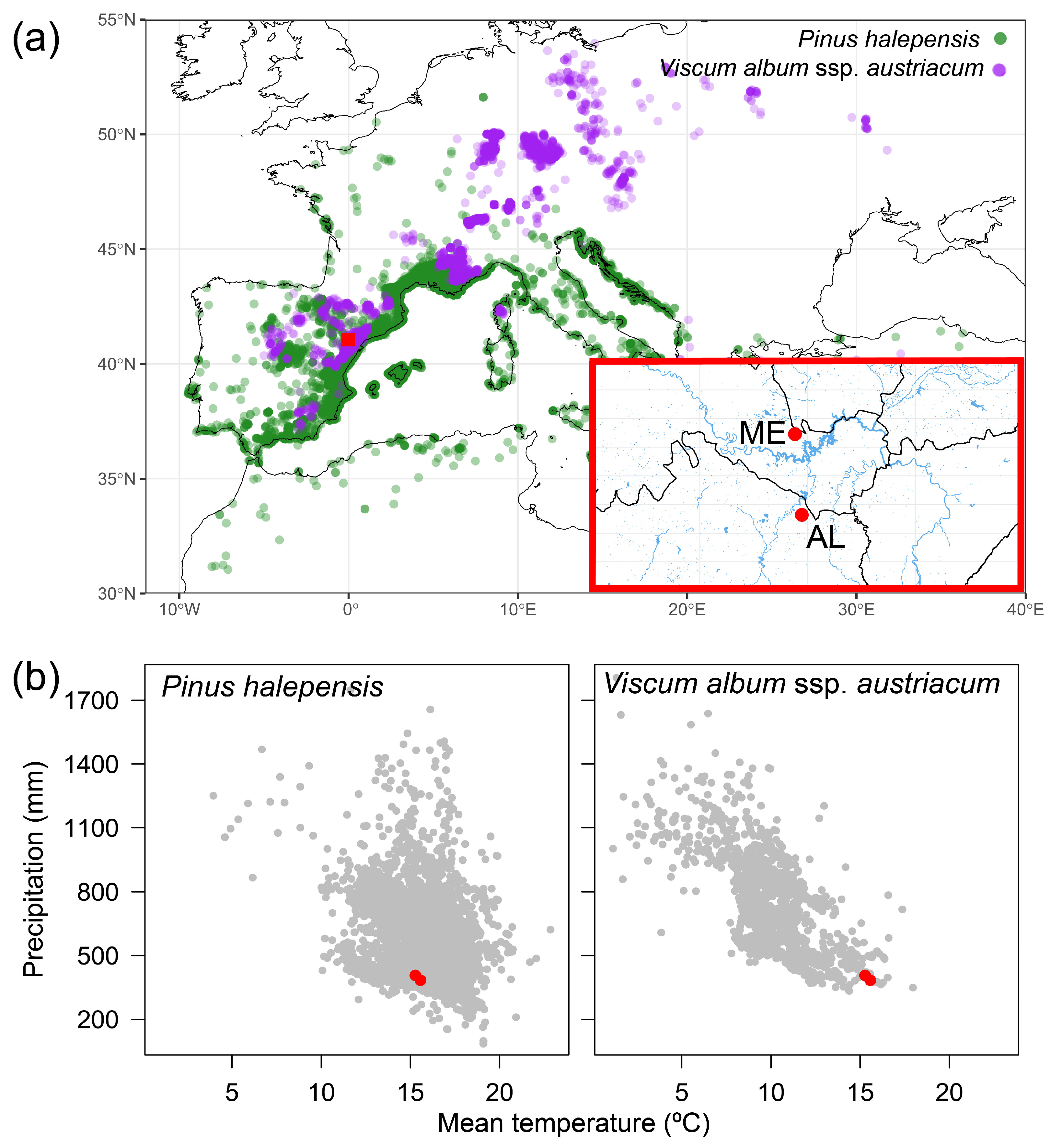

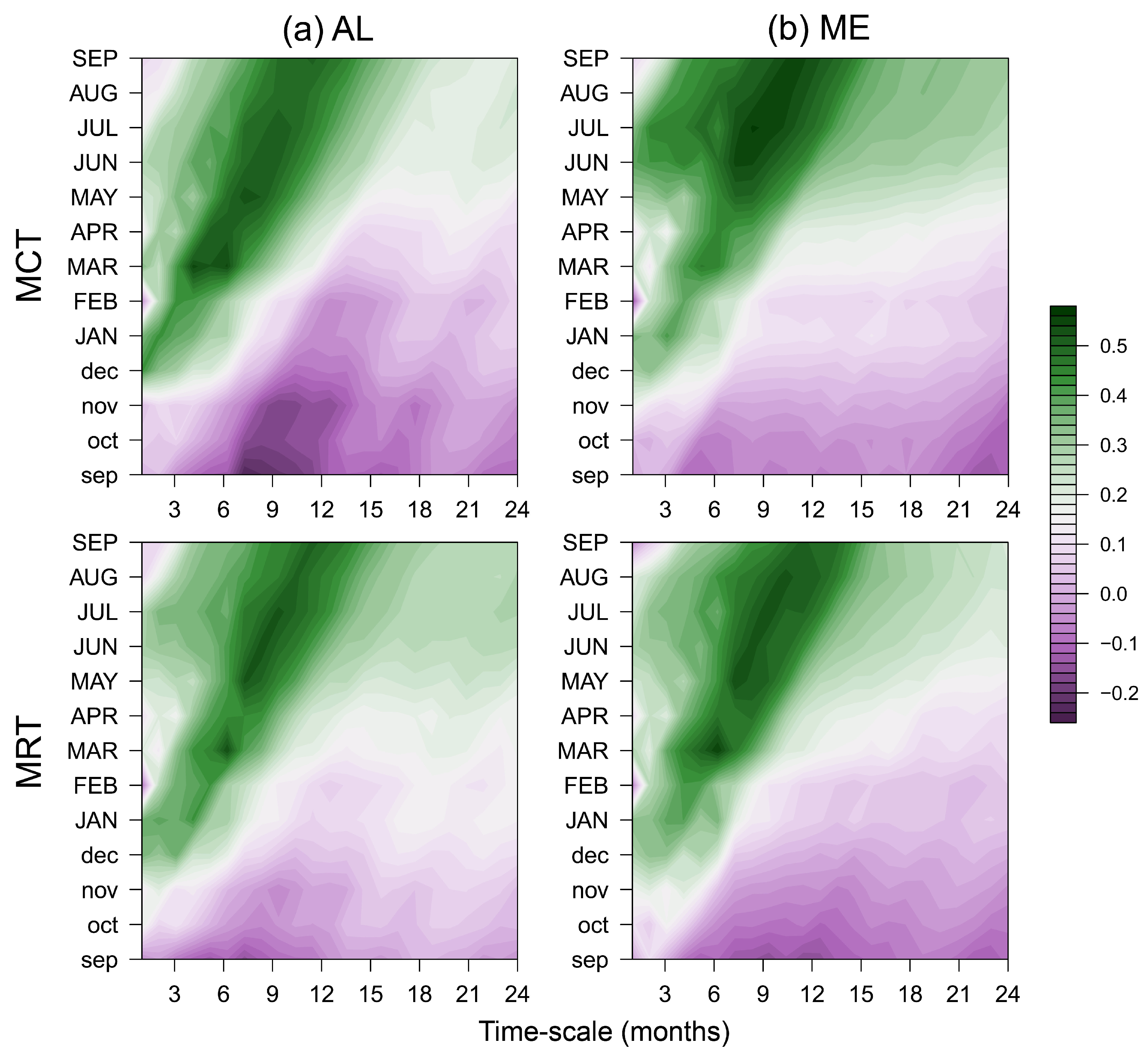

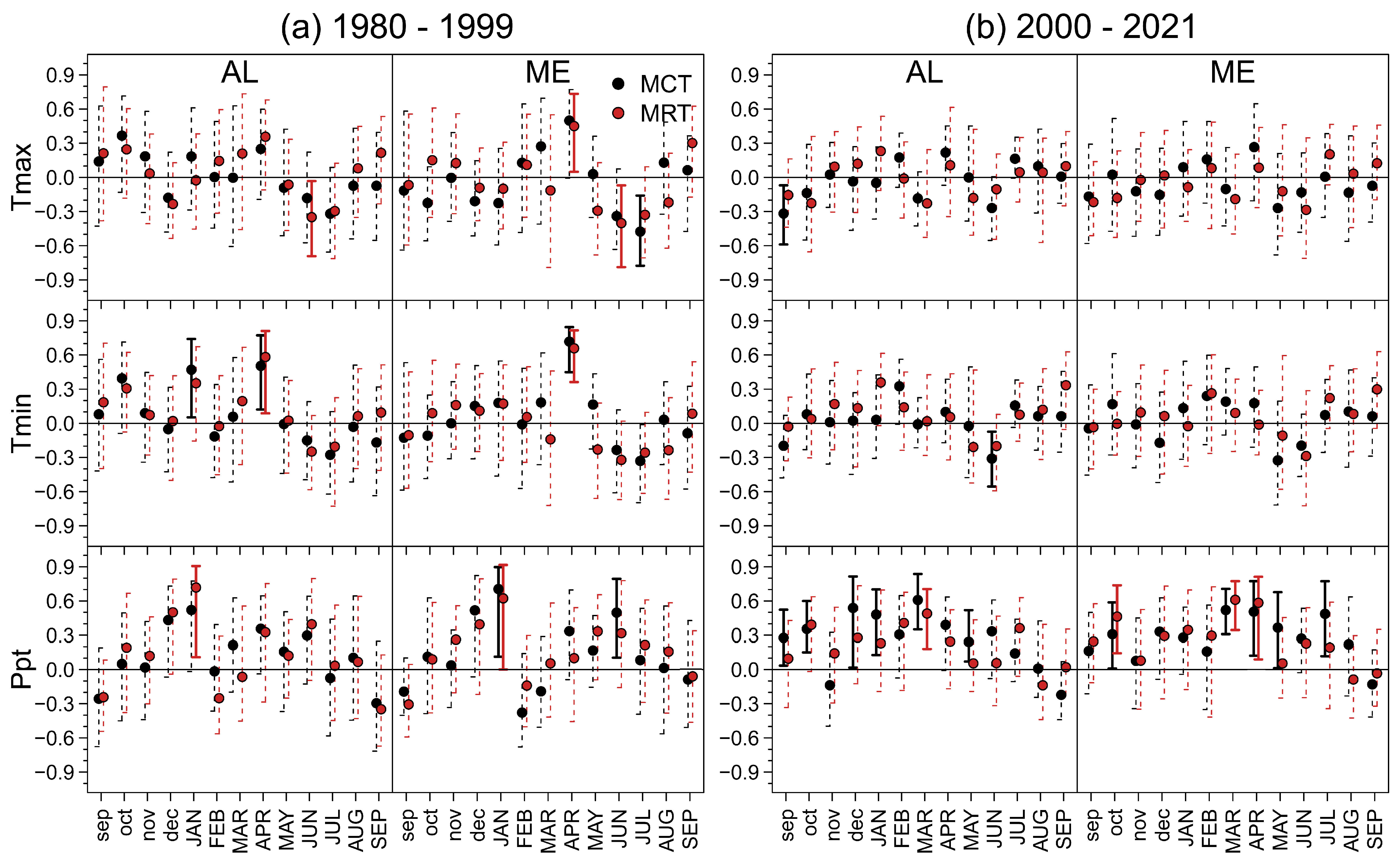
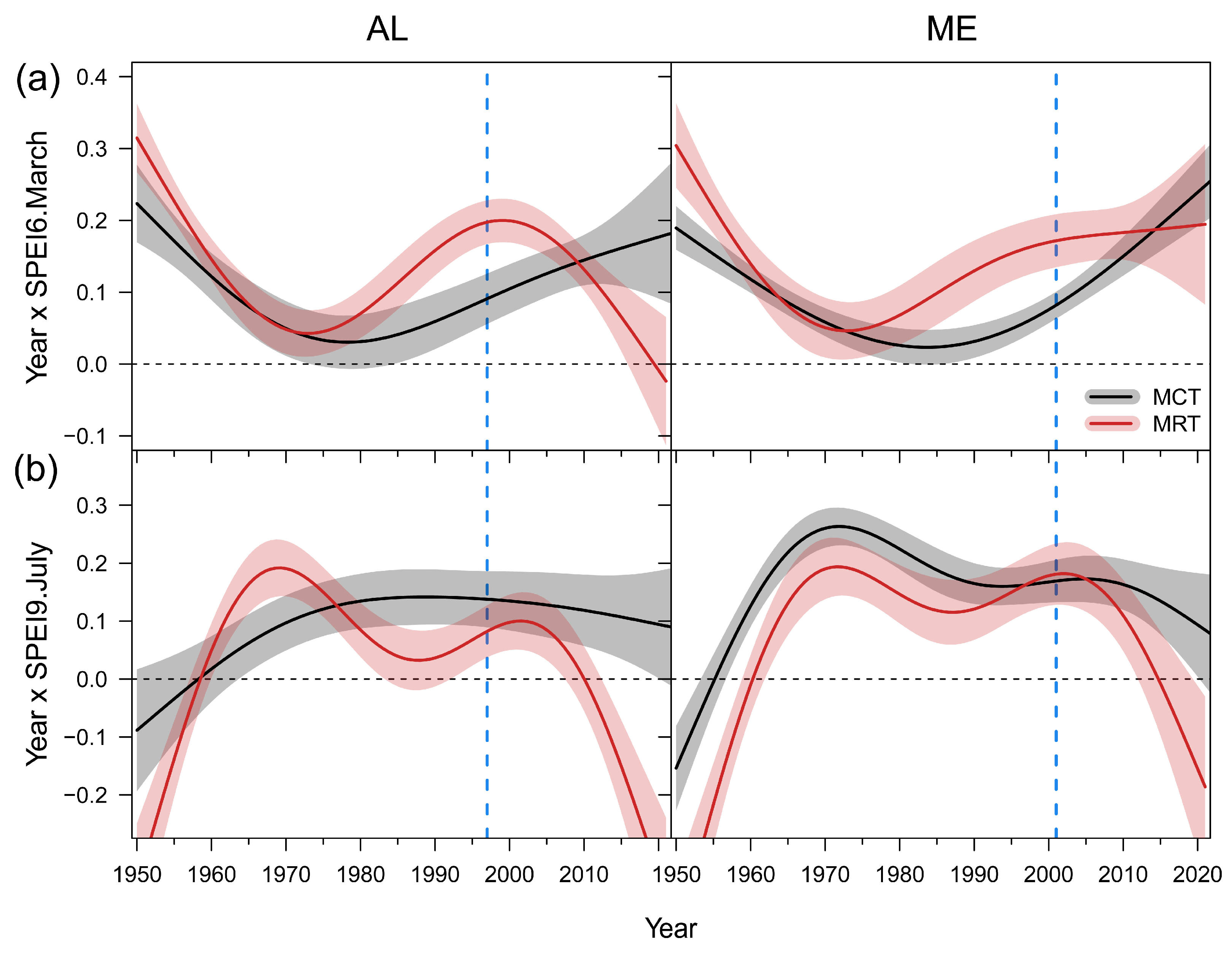
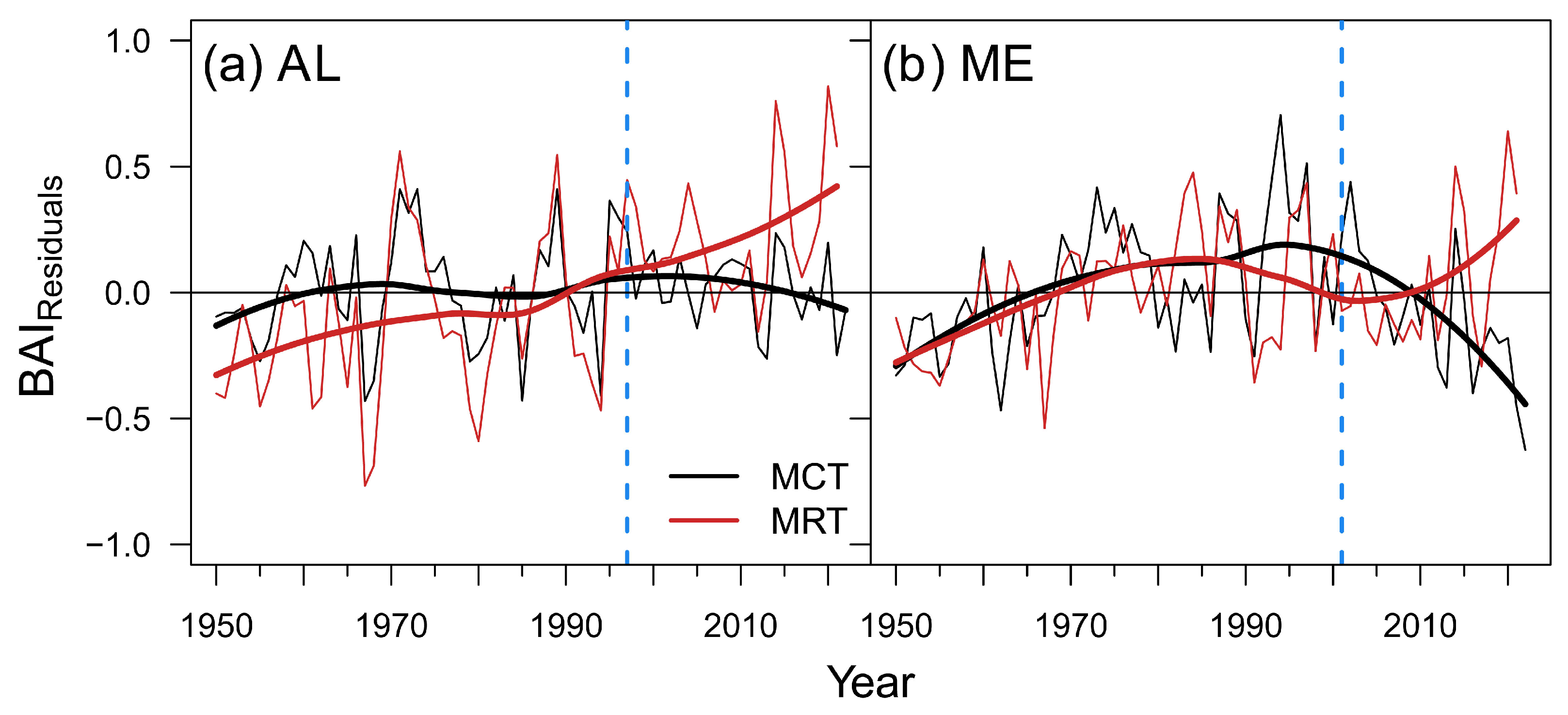
| Variable | Alcañiz (AL) | Mequinenza (ME) | ||
|---|---|---|---|---|
| Mistletoe treatment | MCTs | MRTs | MCTs | MRTs |
| Latitude | 41°4′45″ N | 41°3′50″ N | 41°22′21″ N | 41°20′44″ N |
| Longitude | 0°3′05″ W | 0°1′35″ W | 0°02′41″ E | 0°3′30″ W |
| Elevation (m a.s.l.) | 400 | 440 | 310 | 360 |
| Aspect | SW | E | E-NE | NE |
| DBH (cm) | 27.4 ± 1.9a | 27.4 ± 1.3a | 19.4 ± 0.7a | 15.8 ± 1.6b |
| Tree age at 1.3 m (yrs.) | 96 ± 7a | 93 ± 6a | 85 ± 3a | 111 ± 9b |
| Mistletoe infestation degree | 4.1 ± 0.2a | 0.7 ± 0.3b | 3.1 ± 0.2a | 1.1 ± 0.3b |
| Crown defoliation (%) | 70.1 ± 4.9a | 17.6 ± 2.9b | 63.6 ± 4.2a | 19.1 ± 3.2b |
| No. sampled trees (No. radii) | 16 (31) | 17 (34) | 21 (40) | 15 (30) |
| TRW 1 | 0.78 ± 0.06a | 0.86 ± 0.05a | 0.72 ± 0.03a | 0.62 ± 0.04a |
| AC 1 | 0.54 ± 0.04a | 0.42 ± 0.03a | 0.42 ± 0.02a | 0.45 ± 0.04a |
| EPS 1 | 0.907 | 0.985 | 0.986 | 0.940 |
| Rbar 1 | 0.379 | 0.798 | 0.772 | 0.511 |
| MS 1 | 0.526 | 0.522 | 0.599 | 0.576 |
| Variable | AL | ME | ||||||
|---|---|---|---|---|---|---|---|---|
| MCTs | MRTs | MCTs | MRTs | |||||
| Edf | F | Edf | F | Edf | F | Edf | F | |
| DBH | 1.000 | 3.843* | 1.000 | 31.480*** | 1.000 | 16.180*** | 1.000 | 267.70*** |
| Year x SPEI6.Mar | 3.509 | 21.951*** | 4.926 | 53.200*** | 2.976 | 52.180*** | 4.762 | 39.580*** |
| Year x SPEI9.Jul | 3.943 | 14.455*** | 4.913 | 23.130*** | 4.851 | 16.180*** | 4.871 | 31.180*** |
| R2m | 0.239 | 0.270 | 0.491 | 0.406 | ||||
| R2c | 0.545 | 0.966 | 0.887 | 0.946 | ||||
Disclaimer/Publisher’s Note: The statements, opinions and data contained in all publications are solely those of the individual author(s) and contributor(s) and not of MDPI and/or the editor(s). MDPI and/or the editor(s) disclaim responsibility for any injury to people or property resulting from any ideas, methods, instructions or products referred to in the content. |
© 2024 by the authors. Licensee MDPI, Basel, Switzerland. This article is an open access article distributed under the terms and conditions of the Creative Commons Attribution (CC BY) license (https://creativecommons.org/licenses/by/4.0/).
Share and Cite
González de Andrés, E.; Valeriano, C.; Camarero, J.J. Long-Term Effects of Mistletoe Removal on Radial Growth of Semi-Arid Aleppo Pine Forests. Forests 2024, 15, 1113. https://doi.org/10.3390/f15071113
González de Andrés E, Valeriano C, Camarero JJ. Long-Term Effects of Mistletoe Removal on Radial Growth of Semi-Arid Aleppo Pine Forests. Forests. 2024; 15(7):1113. https://doi.org/10.3390/f15071113
Chicago/Turabian StyleGonzález de Andrés, Ester, Cristina Valeriano, and J. Julio Camarero. 2024. "Long-Term Effects of Mistletoe Removal on Radial Growth of Semi-Arid Aleppo Pine Forests" Forests 15, no. 7: 1113. https://doi.org/10.3390/f15071113






